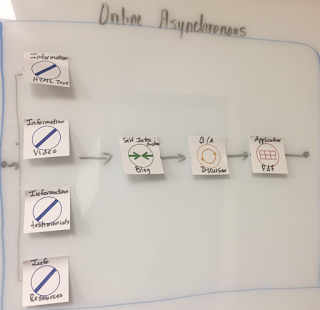I met with Ryan to create the diagnostic model. In preparation for our meeting, he provided a brief summary of a session. He discussed the session using the document as a reference to help me create a diagnostic model of a typical LUCO session. The session began with an online assessment, moved to a full day of classroom information, activities and a great amount of dialogue. It concluded with a homework assignment intended for self reflection.
Friday, December 9, 2016
Thursday, December 8, 2016
Facilitating the Discover Step - Lessons Learned
The discover step was very informative for me in regards to
my LUCO project. The project goal is to
rewrite the program competencies, identify key topics to support each
competency, loosely define assessments, identify 1-2 speakers for each
competency AND make certain that the each compliments but does not contradict
or repeat what might be provided in another leadership program.
The first meeting started with a jump directly into the
assessments, topics and speakers. It
quickly became apparent that the focus was jumping too far ahead and it opened
the committee up to random thoughts and conversations. We were off task and running out of time.
I have been through all three leadership programs at UCO and
I entered the discussion with my prior knowledge and experience having several
biases. First, my experience in the programs does not
match with the intended sequence and goals of the current programs. I experienced repetition in all three
programs both in the competencies and key speakers. I did not perceive a big difference in the
programs. It is important to note that I
was invited to the first meeting prior to the beginning this as a LEDx project
in this course and still, I found myself applying the steps throughout that
first meeting. I contacted Fran Petties
and Ryan Kolb following the meeting and asked if I could use LUCO as my
project. They were both excited and
welcomed the opportunity.
The discover stage helped me identify several immediate
problems or challenges. It brought into
focus the need or the primary goal for LUCO and helped to initiate the first
steps toward a more clearly defined goal.
Looking back on the experience, I wish that I had gone into
the first meeting with the project in mind.
I know I would have been more observant and would have gathered more
critical information.
Monday, November 28, 2016
Design Pattern Swap
I selected a learning environment that is a little bit out
of the ordinary. It was from an
experience I had last spring rafting the Grand Canyon. It fits as a learning environment because
there was a pre-trip requirement that were conducted online and of course the
trip itself was an experiential learning space.
Online Asynchronous
- Information [text, video, testimonials, online resources]
- Application
- Self-introductions and goals [asynchronous discussion]
- Q/A – Dialogue
Experiential
- Information
- Dialogue
- Practice
- Feedback
- Evidence
https://www.pinterest.com/tfairless/lem/
Client Discovery Focus Board
I was asked to join a committee tasked with revising the LUCO program. The committee includes former LUCO members and leaders in LUCO.
Below are my notes from the first meeting using a Focus Board.
The committee met for the first time in early October. I observed early in the meeting that the
eight members bring an energetic energy and passion for leadership initiatives
at UCO. The diversity of experiences,
backgrounds, talents, and goals will both accentuate and complicate the revision
process.
Below are my notes from the first meeting using a Focus Board.
Exploring Design Layers in Learning Environments
The Learning Design Team’s primary responsibility is to
assist faculty as they design online, hybrid and self-paced online
courses. The completed course design
projects are evaluated using a quality rubric that consists of core elements
and five additional sections. With the
goal of passing the evaluation process with a minimum of 90%, the instructional
designers attempt to provide support that will make the design process simple
and efficient. In order to provide
consistent resources and information, the team is building an online resource
to provide the resources for each section in the rubric. The outcome is the production of the online
resource – Course Design Guide.
The strategy used to develop the
resources considered the needs faculty have from the moment of first interest
in designing a course, to the application process, and concluding with
submitting the finished project for evaluation.
Consideration is given to providing just-in-time resources, reducing duplication
of resources, eliminating or at least reducing differing interpretations of the
evaluation rubric.
The system includes face-to-face
meetings to communicate needs and expectations, continued asynchronous support in
the form of email and shared electronic resources, and continual updated
content for the Course Design Guide.
The experience has an impact both on the
faculty involved in the course design projects as well as members of the
instructional design team. The ability
to reference consistent support materials is an important part of the design
process. We have also discussed the
potential impact it could have for the faculty evaluators. They sometimes struggle to apply the rubric
outcomes to the assigned course evaluation.
The Course Design Guide can provide the additional explanation they need
to properly evaluate a course.
Subscribe to:
Comments (Atom)




